|
Thomson’s Influence on
Scottish Art—Review—Popular Indifference—Dr. John Macculloch on
Scenery—Pennant and Johnson—Scott as a Word Painter— Thomson as an
Artist—The Edinburgh Artists—First Edinburgh Exhibition —The Royal
Institution: its History, Exhibitions, and Lord Cockburn on its
Defects—The Scottish Academy.
THE influence of the Rev. John
Thomson on the art world of his day was very remarkable. Never professing
to be anything but an amateur, he was yet a very potent factor in the
origination of the Scottish school of landscapists.
Scotland at the beginning of the
century was miserably far behind in the matter of Art. She had no doubt
produced a few notable portrait-painters, as Jamesone, Allan Ramsay,
Robert Strange, John and Alexander Runciman, Sir William Allan, Sir Henry
Raeburn, and Sir John Watson Gordon. In figure painting she could boast of
W. H. Lizars, Sir David Wilkie, and David Roberts, but no great artistic
thinker had as yet devoted himself to the contemplation of Scottish
scenery. Jacob More, Alexander Runciman, Cowper, and the elder Nasmyth,
although possessed of no mean talents, were decided mannerists after the
Italian, Dutch, or English schools of landscape, drawing their inspiration
from the works of others, not directly from Nature. More and Runciman
invested their subjects with an attempt at classical elegance. Far too
frequently their work was a mere medley of landscape, classic ruins, and
stage figures, in ridiculous and perplexing combination. Following
slavishly in the footprints of the old masters, they looked at Scottish
scenery only through their eyes. Cowper and Nasmyth, catching and blending
the spirit of the old English and the modern Dutch schools, studied minute
and high finish; and in imparting mere sensuous beauty to their details,
lost the truthful delineation of the broader aspects of Scottish scenery.
As has been said, ‘they did not hold the mirror faithfully up to Nature,
for her laws are but feebly indicated in their works. Their pictures
appear indeed to have been painted more to please the eye and fancy than
to instruct the reason or to enlighten or elevate the imagination.’ What
was the result? Among the general public there was really no interest
manifested in landscape whatever. It could not be said to be dead, for it
had never been in existence. Nature was simply ignored, or at all events
was not recognised as a source whence intellectual pleasure might be
derived. The art of perceiving the true beauty of landscape was dormant,
for no artist had as yet presented it in any other than a conventional or
artificial manner. Even so late as 1824 public taste was barely awakened
to the subject. It was in that year that Dr. John Macculloch, in a series
of letters addressed to Sir Walter Scott, and published in four volumes,
on the ‘Highlands and Western Islands of Scotland,’ attempted to attract
public attention to the beauties of Nature as they are to be found in
Scotland. Referring to the neglect that had so long prevailed, he says:
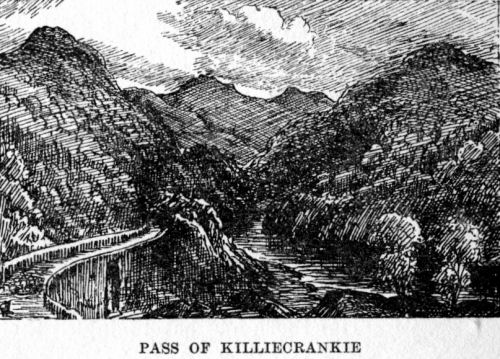
‘We have ourselves almost witnessed
the rise of a very slender degree of taste on the subject. The varied and
beautiful scenery of Scotland had not been dreamt of a century ago. That
of England was equally unknown, though accessible to a larger population
and to one in which the number of the educated was arithmetically if not
proportionably greater; and though the arts were there more diffused, from
the presence of collections of pictures, the possession of ancient
buildings, a longer existence of ornamented villas, and rural scenery,
etc., so little was the scenery of its lakes known, that even the lakes
themselves were scarcely noticed in the popular work on geography which
goes by the name of Guthrie. These beautiful spots are barely mentioned. .
. . You and I,’ addressing Sir Walter, ‘can yet remember when all the
knowledge of Scottish scenery was confined to Loch Lomond and the most
accessible of the Perth-shire lakes. At the time of Pennant’s and
Johnson’s tours, now only fifty years past, scarcely any suspicion of the
beauty of our scenery was entertained; nor, excepting Staffa—too
remarkable a spot to be easily passed without notice—was a single
picturesque object named throughout the country. Johnson could not see
them from physical defects, but Pennant talked of pictures, since he
described those at Dublin and had an artist in his service; yet he has
scarcely mentioned one spot of all that he saw as a man who felt the
beauty of scenery. The account which Birt long before gives of the
"hideous" Highland mountains and glens is absolutely ludicrous. I know not
exactly when Edinburgh was first discovered to be the most romantic city
in the world, but that is a discovery of no high antiquity. I myself was
one of the first, and I believe the first absolute stranger, who
visited Loch Cateran. I had then a Scottish map in which it was not even
inserted. You and the Lady of the Lake can tell another tale now.’
Yes; it required the vivid
word-painting of Walter Scott to awaken, if not to create, a taste for the
beauties of the field, the wood, the lake, and the mountain. Under his
inspiration new ideas and conceptions were formed. Where the old tourists
only saw confusion and deformity, disorder and chaos, ‘black, ugly hills’
and ‘frightful moss-hags,’ he threw the glamour of his witchery over the
scene, and all was changed as if by magic.
It was Scott’s colouring that led
thousands of his countrymen to see Nature no longer as something to be
shunned and avoided, but a source of delight to the eye and the intellect.
‘Boon nature, scatter’d free
and wild,
Each plant or flower, the mountain’s child,
Here eglantine embalm’d the air,
Hawthorn and hazel mingled there;
The primrose pale and violet flower,
Found in each cliff a narrow bower;
Highest of all, where white
peaks glanced,
Where glist’ning streamers waved and danced,
The wanderer’s eye could barely view,
The summer heaven’s delicious blue;
So wondrous wild, the whole might seem
The scenery of a fairy dream.’
What Scott with his pen did to rouse
public taste to a sense of the beautiful, Thomson with his brush was at
the same time assiduously realising on canvas. Working contemporaneously,
on different lines, with different materials, they were almost
unconsciously working towards the same object.
Nor was it the desire for fame
merely that actuated either the one or the other. All such efforts of
genius are involuntary.
The development of Thomson’s genius
evolved and portrayed intuitively the peculiar characteristics of Scottish
landscape, clothing with thought and feeling every object he delineated.
The effort was spontaneous, and as irrepressible as Vesuvius. He did not
paint for fame, but because he could not refrain from painting. Fame was
what he least thought of—indeed, rather shrank from, as bringing his hobby
into competition with his clerical profession.
The applause of the great and those
we love, of those above and those around us, no sane man will ever
despise. To the applause of the ignorant most great men are indifferent;
such fame they regard as the idle clatter of idle tongues. True fame is
often found where it is not sought, and sought where it is often not to be
found. Thomson was not a man inclined to be indifferent to the good
opinion of those he loved, but his best efforts were the outcome rather of
persevering patient study, and an honest desire to master the secrets of
Nature, than of any attempt to rouse the wonder and admiration of friends.
He put his soul into his work, and as a modern writer has remarked, ‘there
is no other fine art than this—the passing of a man’s soul into the work
of his own hands.’
This was undoubtedly the secret of
his wonderful success as an artist; and the pleasure which the pursuit of
Art afforded him confirms the truth of the couplet—
‘Spontaneous joys, where Nature has
its play,
The soul adopts, and owns their first-born sway.’
When Thomson came to Duddingston in
1805 there was then no public representative body to encourage Art; no
public gallery of pictures, and few pictures of any kind to be seen in the
houses of the generality of Edinburgh citizens. It seemed as if that part
of the Second Commandment was as religiously observed in Scotland as in
the land of Israel, forbidding the making of a likeness ‘of anything that
is in heaven above, or in the earth beneath.’
In the houses of the wealthy, family
portraits might be found, the work of Lely, Vandyck, Gainsborough,
Reynolds, Jamesone, Runciman, Nasmyth, or Raeburn, with classical
landscapes from Italy, or rural scenes from Holland, but scarcely ever the
outward and visible characteristics of the Scottish landscape. The few
Scottish painters of the time with any taste for landscape found the
demand for their works so small, that they chiefly relied upon portraiture
as a means of existence. This was the case with Alexander Nasmyth and many
others, who might have made a good figure in landscape had popular taste
given them encouragement. It was, indeed, so far as Art was concerned,
‘the day of small things.’
Gradually, however, public interest
was awakened, and Scottish artists, with a growing sense of what was
expected of them, and realising that by combination they might still
further excite public attention to their craft, resolved upon an
exhibition of their work. The first public exhibition of pictures in
Edinburgh was held in Corn’s Rooms, sometimes called the ‘Lyceum,’
Nicolson Street, in 1808.
In the following year the
Association of Artists held their second exhibition in the art gallery of
Henry Raeburn, which that artist had just erected for himself in what is
now No. 32 York Place. At this exhibition 205 pictures were shown, but
Thomson sent only one specimen from his easel, viz, a ‘Landscape
Composition.’ And from the catalogues it would appear that he contributed
nothing to the exhibitions held in the three following years. His interest
in the movement revived again in 1813, for we find that in that year he
sent two pictures.—a ‘View near Tynninghame,’ and the ‘Glen of the Calder
Burn, Lanarkshire.’ In 1814 he exhibited three, and in 1815 no less than
six, including ‘Derwent Water,’ ‘View of Duddingston House‘—a large
work—’View of Duddingston Loch,’ and the ‘Lower Fall of Dalkairney,
Ayrshire.’
The number of works thus exhibited
in Edinburgh yearly was about two hundred, but so apathetic were the
public, and so disheartened were the painters, that the exhibitions could
only with difficulty be kept up. In 1815 the number of exhibits had fallen
to 176, and in the following year it was even worse, for they only
numbered 150. So far native Art could not boast of great success, and the
artists, doubtless disheartened and disgusted with the general
indifference of the public, relinquished the annual exhibition altogether,
and the society, which numbered only fifteen members, including Mr.
Thomson, came to an end.
Notwithstanding the non-success of
these exhibitions, Thomson’s work as a landscape painter was receiving a
considerable amount of attention from those in the upper walks of life,
for at this time he was so inundated with orders for pictures that it is
said he had difficulty in meeting the demand.
Thus far the Edinburgh exhibitions
had doubtless attracted public notice to his work.
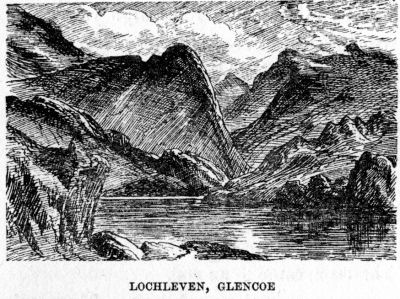 After
an interval of several years, public interest in Scotland was revived by
the establishment in February 1819 of the Royal Institution for the
Encouragement of the Fine Arts. This fresh effort was not confined to
artists; rather it was the enlightened impulse of the rank and talent of
Scotland to remove what they considered a national reproach, and to
elevate the public taste of the community. It was largely supported by the
nobility and landed gentry, many of whom had excellent collections of
works of art, of priceless value, the accumulations of several
generations. The object of these gentlemen was a most praiseworthy one,
viz. that these treasures, which were in a measure inaccessible to the
general public, should from time to time be brought together for public
exhibition in the Capital. After
an interval of several years, public interest in Scotland was revived by
the establishment in February 1819 of the Royal Institution for the
Encouragement of the Fine Arts. This fresh effort was not confined to
artists; rather it was the enlightened impulse of the rank and talent of
Scotland to remove what they considered a national reproach, and to
elevate the public taste of the community. It was largely supported by the
nobility and landed gentry, many of whom had excellent collections of
works of art, of priceless value, the accumulations of several
generations. The object of these gentlemen was a most praiseworthy one,
viz. that these treasures, which were in a measure inaccessible to the
general public, should from time to time be brought together for public
exhibition in the Capital.
The original membership was fifty,
and in the list of twenty-seven directors we have the name of one Duke—the
Duke of Argyle; two Marquises—Tweeddale and Queensberry; the Earls of
Haddington, Elgin, Wemyss, Hopetoun, and Fife; a number of Baronets,
including Sir William Forbes, Sir John Hay, Sir George Clerk; and of those
who no doubt formed the working portion of the board, John Clerk of Eldin,
Alexander Oswald of Auchencruive, Alexander Gordon, Adam Fairholm, and
Professor Alexander Russell, who acted as secretary.
The first exhibition of the
Institution took place in the gallery of Henry Raeburn in York Place, and
the small but very fine collection was opened to view on 11th March 1819.
It was entirely composed of the works of the old masters, both foreign and
British; and in the catalogue are found the names of Rubens, Tintoretto,
Poussin, Vandevelde, Vernet, Cuyp, Wouvermans, Hobbema, Ostade,
Caravaggio, Titian, Velasquez, Vandyck, Guido Reni, etc. etc. Lord
Cockburn says of it that ‘it was the best exhibition of ancient pictures
that had ever been brought together in this country, all supplied from the
private collections of its members and friends.’
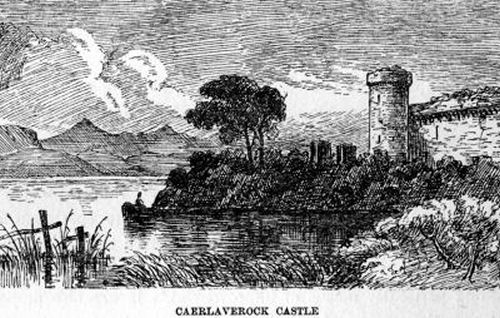
Encouraged by the success of this
effort, a second exhibition was held in the spring of 1820, which also
attracted much public attention. The Institution, now seen to be supplying
a long-felt want, received a large accession to its membership, and in
1821 we find it had increased to 130, among the list occurring the name of
Sir Walter Scott; while the Rev. John Thomson was elected an Honorary
Member along with Sir David Wilkie, Patrick Nasmyth, and several other
artists.
The exhibition this year was chiefly
composed of modern pictures, but Thomson was not a contributor.
For a few years the works of the
‘ancient masters,’ and modern pictures, constituted alternately the
exhibitions of the Institution, and there is no doubt that they
contributed largely to the rapidly growing taste for Art which now
manifested itself in Scotland.
These exhibitions were of a
migratory character, for the Institution, having no building of its own,
was indebted for accommodation to private parties, so that while for the
most part they took place in Sir Henry Raeburn’s gallery in York Place,
one or two of them were held in ‘Mr. Bruce’s gallery, Waterloo Place,’ Mr.
Bruce being a picture-dealer of some repute.
The completion of the elegant
Grecian building on the Mound in 1826, for the accommodation of the Royal
Institution, gave it a new impulse, and its management now proposed not
only to have periodical public exhibitions for the sale of the works of
British artists, but to purchase such works for the Institution for
permanent exhibition; while ‘in order to excite emulation and industry
among the younger artists, they resolved to offer premiums for competition
to assist them to visit London or other places affording particular means
of improvement.’ It was also proposed to secure the means of affording
relief to artists suffering from adverse circumstances, or ‘to the
families of any such, when deprived by death of the benefit of their
talents and exertions.’ All of which objects were most laudable, and were
in some measure realised.
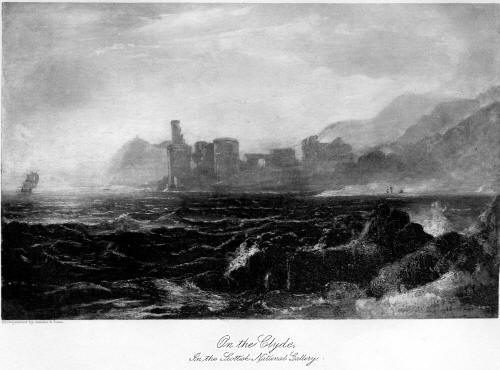
Portraiture formed a large and
prominent feature of these early exhibitions, for if one may judge from a
jocular remark of Sir Walter Scott, the modern landscapes shown were
frequently of so inferior a quality as to earn the epithet of the
‘tea-board style of Art.’ The new impulse of the Wilsons, ‘Grecian’
Williams, and above all Thomson, was a development which, while the
conventional in Art was not altogether discarded, was inspired by a deeper
insight into Nature’s secrets, for ‘in their works there was felt the
breath of a new life.’ But while Thomson shares with them the honour of
having given this first impulse to Scottish
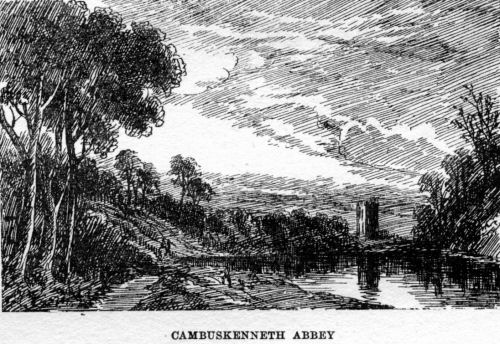
landscape art, his personality
lifted him high above them and his other contemporaries.
Thomson’s contributions to these
exhibitions were neither few nor insignificant, and were certainly not of
the ‘tea-board’ style, as the following facts will show.
In 1822 he showed four paintings,
among which appears his ‘Aberlady Bay,’ now in the National Gallery; ‘Cambuskenneth,’
now in the collection of the Right Hon. Lord Kingsburgh; and ‘Dunbar
Castle.’
In 1824 Thomson showed six works,
all of superior excellence. These were ‘Fast Castle,’ and ‘Part of
Caerlaverock Castle’ (also the property of Lord Kingsburgh), ‘Coire-nan-Uriskin,’
‘Prestonpans,’ ‘Fast Castle with the Bass Rock in the distance,’ and ‘A
View from the Grounds of Hillside.’
In 1826 he exhibited five paintings,
among which was the ‘Dunluce Castle’ which so roused the admiration of Sir
Walter
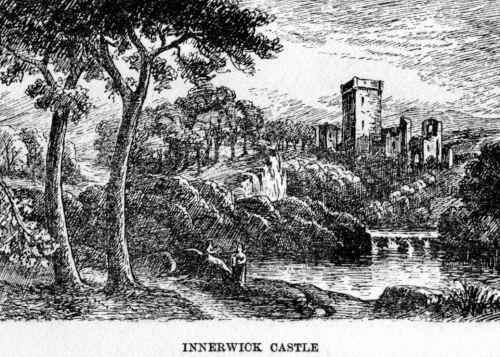
Scott, a magnificent gallery
picture, measuring about eight feet in length by about five in depth.
In the following year he appeared in
great force, having no less than twelve pictures hung in the exhibition on
the Mound. Among these are to be found ‘Inchgarvie,’ now the property of
the Earl of Rosebery; ‘Innerwick Castle,’ the property of the Duke of
Buccleuch; ‘Kilohurn Castle,’ ‘Loch Katrine,’ ‘Tantallon Castle,’ etc.
Again in 1828 he was a large
contributor, this collection having his picture of ‘Turnberry Castle,’
also referred to in the Journal of Sir Walter, which was purchased
by the Royal Institution at the moderate price of fifty guineas, and now
forms a part of the National Gallery collection.
During the eleven years of the
active existence of the Royal Institution’s exhibitions, Thomson loyally
supported it, contributing close upon eighty pictures during that period;
and when, in the fulness of time, the Royal Scottish Academy was in 1829
fairly launched into the world, and took its place in the direction and
promotion of the Scottish School of Art, we find him equally helpful.
We have already referred to his
influence over individual artists who have made the Scottish School
famous, but his influence and power in the formation both of the Royal
Institution and the Academy were no less important.
The permanent ascendency of the
Institution in the guidance of Scottish Art was not, perhaps, to be
expected. It partook too much of the element of patronage to be long
successful. What was wanted was a spirit of emulation, combined with
brotherly help in a common cause, among the artists themselves. Lord
Cockburn, who was a good deal mixed up with the controversies out of which
the Academy had its birth, and was able to judge of its ‘defects and
vices,’ tells us in his Memorials of his Time, that ‘the
Institution begun under great names had one defect and one vice. The
defect was that it was calculated to do little or nothing for Art, except
by such exhibitions, which could not possibly be kept up long, for the
supply of pictures was soon exhausted. A rooted jealousy of our living
artists as a body (not individually) by a few persons who led the
Institution was its vice. These persons were fond of Art, no doubt, but
fonder of power, and tried indirectly to crush all living Art and its
professors, who ventured to flourish except under their sunshine. The
result was that in a few years they had not a living artist connected with
them. Their tyranny produced the Academy, and then having disgusted the
only persons on whose living merit they could depend, the Institution
itself sank into obscurity and uselessness.’
Knowing the parties concerned, and
all the circumstances of the case as he did, there is doubtless much truth
in Lord Cockburn’s opinion, even though it be saturated with more of the
‘special pleader’ than the impartial judge. It lets us in behind the
scenes, however, and that is everything in historical study.
The Academy was thus, it appears, an
outcome of the Royal Institution, or rather a secession from it, in which
the artists sought freedom to manage their own affairs. Being denied a
share of the management of the exhibitions, a number of the associates,
disgusted with the treatment to which they were subjected, formed
themselves in 1826 into an association which they called the Scottish
Academy. it had its first exhibition in No. 24 Waterloo Place in 1827, and
for two or three years thereafter, in spite of a formidable combination
arrayed against it, the exhibitions increased in popularity. The
membership consisted of thirteen academicians, nine associates, and two
associate engravers, but after a time the associates of the Royal
Institution made overtures for admission to its privileges.
‘When the Academy was first formed,’
says Lord Cockburn, ‘it consisted merely of the artists who were
particularly displeased with the Institution; the majority, and the best
of their brethren, still adhering to that body. After about two more
years’ experience of the management
of the Institution, it was found by the adherents—or associates—that there
could be no cordial union between them and it, and not even a comfortable
endurance of each other. Each as usual blamed the other, and I, who knew
the whole facts, think that though there was unreasonableness on both
sides, the artists had the least of it. It was plain, however, that they
must part.’ But they were in an
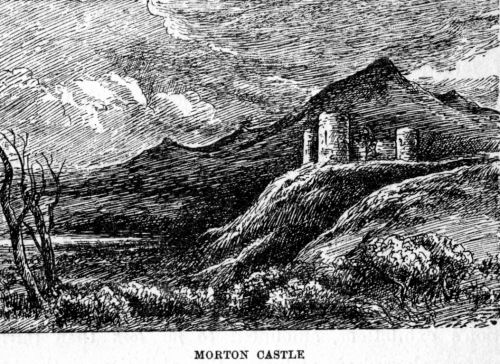
awkward position. On the one hand
wincing under the consciousness of their subordinate position in
connection with the Institution, while they had cut themselves off from
the Academy, which was succeeding without their aid and against their
will. In these circumstances they made an abortive attempt to found
another Scottish Academy rather than join that already formed. Ultimately,
however, having in 1829 broken with the Institution, whose intolerable
management they could no longer endure, and smarting under the failure of
the attempt made to organise a constitution for themselves, they gave way
to the expostulation of friends. Overtures were made through Henry
Cockburn to the Academy for their admission as members in a body. This
application somewhat embarrassed the Academy, then, as we have said,
consisting of only fifteen members, coming as it did from twenty-four
artists, who might thus virtually swamp the original founders.
At length in July 1829, through the
intervention of Mr. Hope, the Solicitor-General for Scotland, and
Cockburn, a union of the artists was effected, and the re-formed Academy,
with a membership now of forty-two, started afresh on its career. This
left the Institution without a single artist connected with it. Thomson,
not being a professional artist, does not appear to have been mixed up in
any way with the differences and contentions of this period. He would, no
doubt, have his sympathies with the artists, but to the last he supported
the Institution in their exhibitions. These were continued till 1830,
after which the secession of the artists rendered their continuance
impossible. He certainly was not idle. His exhibits during the years 1827,
1828, 1829, and 1830, in the Institution’s exhibitions, amounted to no
less than thirty-four, while he only showed one picture in the exhibitions
of the Academy for these same years. When the Institution at length gave
up the unequal competition and the Academy held the field, Thomson as
loyally supported it, and from 1831 till 1840 contributed several pictures
annually to its exhibitions. Some of those painted during this period are
among his largest and most important works. |

